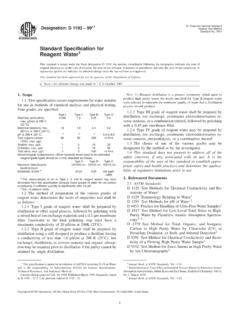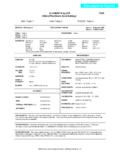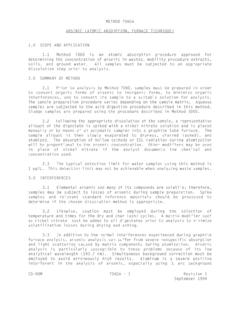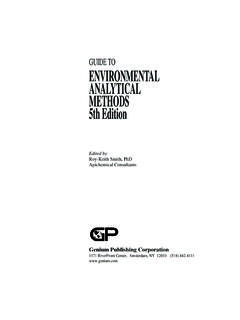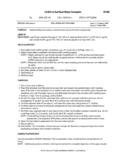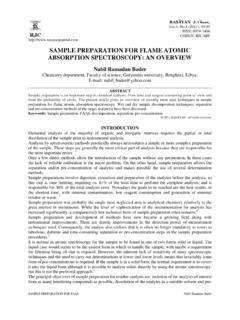Transcription of Water for analytical laboratory use — Specification …
1 BRITISH STANDARDBS EN ISO 3696:1995 Incorporating Amendment No. 1 Water for analytical laboratory use Specification and test methodsThe European Standard EN ISO 3696:1995 has the status of a British StandardPuring Technology( ), Uncontrolled Copy, (c) BSIBSENISO3696:1995 This British Standard, having been prepared under the directionof the Chemicals Standards Committee, was published under the authority ofthe Board of BSI and comes intoeffect on 31 December 1987 BSI 10-1999 First published February 1966 First revision December 1987 The following BSI references relate to the work on this standard:Committee reference CIC/26 Draft for comment 83/55146 DCISBN 0 580 16312 1 Committees responsible for this British StandardThe preparation of this British Standard was entrusted by the Chemicals Standards Committee (CIC/-) to Technical Committee CIC/26, upon which the following bodies were represented:British Pharmacopoeia CommissionChemical Industries AssociationInstitute of PetroleumMilk Marketing BoardRoyal Society of ChemistrySociety of Glass TechnologyTextile InstituteThe following bodies were also represented in the drafting of the standard, through subcommittees and panels.
2 British Ceramic Research AssociationBritish Effluent and Water AssociationStandardization of Tar Products Tests CommitteeAmendments issued since publicationAmd. of issueComments8807 September 1995 Indicated by a sideline in the marginPuring Technology( ), Uncontrolled Copy, (c) BSIBSENISO3696:1995 BSI 10-1999iContentsPageCommittees responsibleInside front coverNational forewordiiForeword21 Scope and field of application32 Description33 Classification34 Requirements35 Sampling36 Storage37 methods of test48 Test reports6 Table Requirements4 Puring Technology( ), Uncontrolled Copy, (c) BSIBSENISO3696:1995ii BSI 10-1999 National forewordThis British Standard has been prepared under the direction of the Chemicals Standards Committee.
3 It is identical with ISO3696:1987 Water for analytical laboratory use Specification and test methods , published by the International Organization for Standardization (ISO).In 1995 the European Committee for Standardization (CEN) accepted ISO3696:1987 as European Standard EN ISO3696. As a consequence of implementing the European Standard this British Standard is renumbered as BSEN ISO3696 and any reference to BS3978 should be read as a reference to BS EN standard is a revision of BS3978:1966, which is withdrawn. The principal changes in this edition are as ) The single grade of Water has been replaced by three grades, of which grade3 is roughly equivalent to the Water specified in the previous ) Residue on ignition is no longer specified and the requirement (for grade3 Water ) for residue on evaporation has been ) Electrical conductivity is now measured at25 C instead of20 C, and the requirement for grade3 Water has been changed from1mS/m ) The limit for oxidizable matter for grade3 Water has been ) Requirements for ammonia content, chloride content and sulphate content are no longer and conventions.
4 The text of the International Standard has been approved as suitable for publication as a British Standard without deviation. Some terminology and certain conventions are not identical with those used in British Standards; attention is drawn especially to the comma has been used as a decimal marker. In British Standards it is current practice to use a full point on the baseline as the decimal symbol l has been used to denote litre (and in its submultiples). In British Standards it is current practice to use the symbol L .The spelling sulfur , been used. In British Standards it is current practice to use the spelling sulphur , the words International Standard appear, referring to this standard, they should be read as British Standard.
5 Additional information. If Water complying with BS3978 is specified in another British Standard without stating which grade should be used, it is recommended that grade3 be used (see clause3).Textual errors. When adopting the text of the International Standard, the textual errors listed below were discovered. They have been marked in the text and have been reported to ISO in a proposal to amend the text of the International ) In the note to clause5 the cross-reference should read see note2 to clause4 .b) In paragraph 1, line3 , the reference should be and paragraph 1, line4 , mix the sample with a dry should read mix with the sand using a dry .Puring Technology( ), Uncontrolled Copy, (c) BSIBSENISO3696:1995 BSI 10-1999iiiA British Standard does not purport to include all the necessary provisions of a contract.
6 Users of British Standards are responsible for their correct with a British Standard does not of itself confer immunity from legal of pagesThis document comprises a front cover, an inside front cover, pagesi toiv, theENISO title page, pages2 to6 and a back standard has been updated (see copyright date) and may have had amendments incorporated. This will be indicated in the amendment table on the inside front Technology( ), Uncontrolled Copy, (c) BSIivblankPuring Technology( ), Uncontrolled Copy, (c) BSIEUROPEAN STANDARDNORME EUROP ENNEEUROP ISCHE NORMENISO 3696 April1995 ICS : Inorganic chemistry, chemical analysis, chemical reagents, Water , classification, Specification , tests, storageEnglish versionWater for analytical laboratory use Specification and test methods (ISO 3696:1987)Eau pour laboratoire usage analytique Sp cification et m thodes d essai (ISO3696:1987)Wasser f r analytische Laborzwecke- Spezifikation und Pr fverfahren (ISO3696:1987)This European Standard was approved by CEN on 1995-02-13.
7 CEN membersare bound to comply with the CEN/CENELEC Internal Regulations whichstipulate the conditions for giving this European Standard the status of anational standard without any lists and bibliographical references concerning such nationalstandards may be obtained on application to the Central Secretariat or to anyCEN European Standard exists in three official versions (English, French,German). A version in any other language made by translation under theresponsibility of a CEN member into its own language and notified to theCentral Secretariat has the same status as the official members are the national standards bodies of Austria, Belgium,Denmark, Finland, France, Germany, Greece, Iceland, Ireland, Italy,Luxembourg, Netherlands, Norway, Portugal, Spain, Sweden, Switzerland Committee for StandardizationComit Europ en de NormalisationEurop isches Komitee f r NormungCentral Secretariat.
8 Rue de Stassart 36, B-1050 Brussels 1995 All rights of reproduction and communication in any form and by any means reserved in allcountries to CEN and its membersRef. No. EN ISO 3696:1995 EPuring Technology( ), Uncontrolled Copy, (c) BSIENISO3696:1995 BSI 10-19992 ForewordThe text of the International Standard has been taken as a European Standard by the Technical Committee CEN/TC19, Petroleum products, lubricants, and related products, from ISO/TC47, Chemistry, of the International Organization for Standardization (ISO).This European Standard shall be given the status of a national standard, either by publication of an identical text or by endorsement, at the latest by October1995, and conflicting national standards shall be withdrawn at the latest by to the CEN/CENELEC Internal Regulations, the following countries are bound to implement this European Standard: Austria, Belgium, Denmark, Finland, France, Germany, Greece, Iceland, Ireland, Italy, Luxembourg, Netherlands, Norway, Portugal, Spain, Sweden, Switzerland and Technology( ), Uncontrolled Copy, (c) BSIENISO3696.
9 1995 BSI 10-199931 Scope and field of applicationThis International Standard specifies the requirements and corresponding test methods for three grades of Water for laboratory use for the analysis of inorganic is not applicable to Water for organic trace analysis, to Water for the analysis of surface active agents, or to Water for biological or medical some purposes (for example for certain analytical methods or for tests in which the Water is required to be sterile or pyrogen-free or of specified surface tension), additional specific tests and further purification or other treatment may be DescriptionThe material shall be a clear, colourless liquid as assessed by visual ClassificationThis International Standard covers three grades of Water as follows:Grade 1 Essentially free from dissolved or colloidal ionic and organic contaminants and suitable for the most stringent analytical requirements including those of high-performance liquid chromatography; should be produced by further treatment of grade2 Water (for example reverse osmosis or deionization followed by filtration through a membrane filter of pore size0,24m to remove particulate matter or redistillation from a fused silica apparatus).
10 Grade 2 Very low in inorganic, organic or colloidal contaminants and suitable for sensitive analytical purposes, including atomic absorption spectrometry (AAS) and the determination of constituents in trace quantities; should be produced, for example, by multiple distillation, or by deionization or reverse osmosis followed by 3 Suitable for most laboratory wet chemistry work and preparation of reagents solutions; should be produced, for example, by single distillation, by deionization, or by reverse osmosis. Unless otherwise specified, it should be used for ordinary analytical is assumed that the initial feed stock Water is potable and reasonably pure. If it is heavily contaminated in any respect, some pretreatment may be RequirementsThe material shall comply with the appropriate requirements of the Table.
